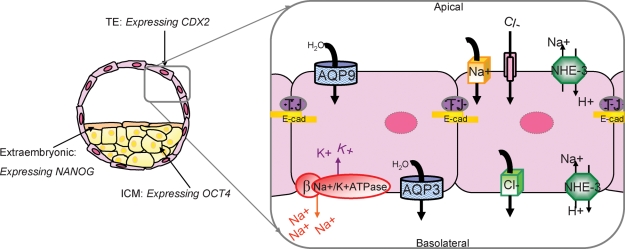Figure 2:
Preimplantation embryo cell lineage specification and blastocyst formation model.
Recent research applied to the mouse has established that TE and ICM differentially express several lineage-specific transcription factors. Cdx2 becomes restricted to the TE and is required for TE formation (Yamanaka et al., 2006). In contrast, Oct4 and Nanog become restricted to and influence ICM fate (Yamanaka et al., 2006). This research supports a model that proposes mutual antagonism between Oct4 and Cdx2 in supporting the formation of TE and ICM fates in the blastocyst (Yamanaka et al., 2006). Our research has been directed at understanding the mechanisms that control blastocyst formation, which is dependent upon TE differentiation, as it is the ion and water transport functions of the TE that mediate the fluid dynamics that control cavitation (Watson et al., 1992; Watson and Barcroft, 2001). Na/K-ATPase, AQP (water channels) and tight junction (TJ) proteins have established roles in coordinating blastocyst formation (Watson et al., 1992; Watson and Barcroft, 2001). Our model predicts that blastocyst formation is dependent upon the polarized distribution of the Na/K-ATPα1β1ase confined to the basolateral membrane domains of the TE. This establishes a trans-TE ion gradient that facilitates movement of water across the epithelium facilitated by the presence of both apical and basolateral AQPs. These events combined with the establishment of a TE tight junctional seal to prevent the loss of fluid out of the embryo through paracellular routes result in the expansion of the embryo and the formation of the blastocyst (Watson and Barcroft, 2001) E-cad, E-cadherin; NHE-3, sodium–hydrogen exchanger 3.

